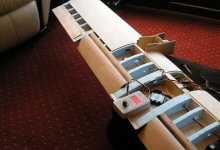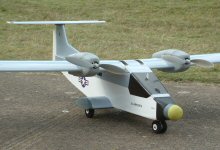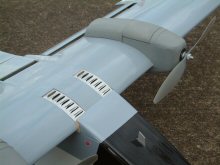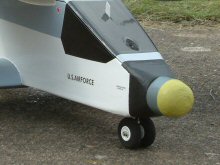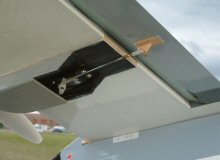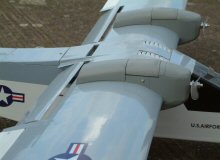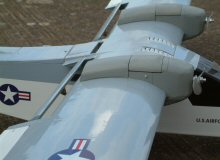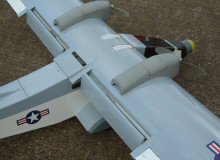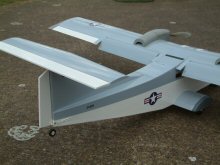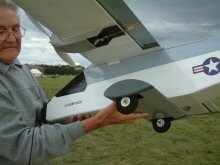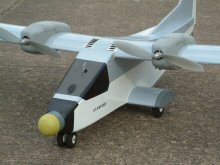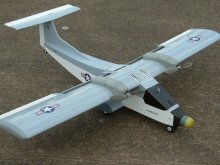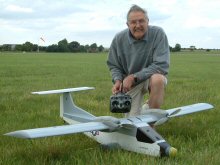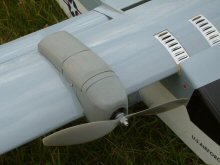|
|||
|
|
|
||
| View Shopping Cart |
| Home |
| Guides Available |
| About the Author |
| FAQs |
| Testimonials |
| Articles |
| Contact Andrew |
| Terms & Conditions |
| Mailing List |
| Links |
 |
 |
More high quality information absolutely
free with every
Gibbs Guides newsletter. Sign
up now!
John Swain's Stoltac
Article by Andrew Gibbs
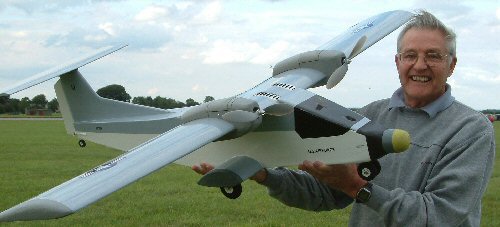
This distinctive electric twin motor model, designed and built by John Swain, caught my eye while I was at one of the BMFA Nationals. Now retired, John is an enthusiastic modeller. He is a former RAF pilot (Hawker Hunter, lucky man!) and also a former airline pilot. I think it is fair to say that John’s full size flying experience is reflected to some extent in the design of this most interesting model.
John named his distinctive design Stoltac, which is a convenient abbreviation of Short Take Off and Landing Tactical Aircraft. The model’s 11 inch (280 mm) chord wing spans 72 inches (1,830 mm), so it’s got plenty of area – 5 ½ square feet, or 792 square inches or so. With a flying weight of 9 ½ lbs (4,300 g) the wing loading works out at just under 28 oz/sq ft.
Power system
For power, the model employs a pair of EMax BL2826 motors
driving 12x6 slow fly propellers. Two 50 Amp ESCs are
used, one for each motor. The model was originally flown
with two large packs of 3S LiPo batteries, one per motor.
To start with, these were of 6,400 mAh capacity, but were
changed to 5,300 mAh packs. These still had more than
enough capacity, providing sufficient energy for 30 minutes
of flight. The batteries live in the nose, and their weight
is necessary to achieve the correct balance point (CG).
| The wing of the Stoltac uses blue foam ribs. This is another example of John’s imaginative thinking (click small images to enlarge). | This atmospheric ‘might have been’ model enjoys an attractive naval gray and white colour scheme (click small images to enlarge). |
10 minutes of flying consumes between 1,500-2,000 mAh, meaning that the motors are operating at an average of about 9 to 12 Amps each, equivalent to 100 – 135 Watts of input power. This works out at an average in flight consumption of between 21 and 28 Watts per pound. This may not sound like much, but of course that’s an average over the course of a whole flight, and the model would be un flyable unless a lot more was available when required. Still it does go to show how efficient this imaginative model is.
Asymmetric problems
Originally, each of the motors is fed by its own battery, and this meant
that an asymmetric situation could be caused by one battery becoming flat
before the other. John did experience this with his model; one battery
had a poor cell, as a result of which the associated motor stopped. The
model quickly entered a spin due to the resulting asymmetric condition.
John promptly shut the throttle, whereupon the model became flyable again.
To guard against this asymmetric problem happening again, John wired the batteries in parallel, linking left and right systems. This meant that the motors would share both batteries, so in theory since the ESCs were fed the same voltage, they should behave identically. In practice however, one will shut down before the other, so wisdom dictates that the model should not be flown until the batteries are near to exhausted.
| 4 Cooling air is admitted through the perforated metal intakes in the centre section and supplies the ESCs which are located inside the wing. The warmed air exits through a vent beneath the wing. | 5 The design of the nose is intended to represent a radar installation and helps to give the model a purposeful military appearance. The large flat windscreen serves as a battery hatch. |
Later on, John decided he wanted the option of being able to fly the model using only one battery, so he lengthened the nose so that the weight of a single battery would still be enough to achieve the required CG. This of course had the benefit of significantly reducing the model’s weight.
Colour Scheme
The model's colour scheme is both attractive and practical.
The contrast between the gray and white provides a strong
horizontal line. This detail allows the model’s
flight attitude (in other words, is the model's attitude
nose up, nose down or what?) to be easily judged while
it’s in flight.
One of the things I’ve noticed that beginners struggle with when flying models is estimating the model’s flight attitude, and an appreciation of this is vital to be able to master model flying. It would be good to see this sort of detail applied to training models for this reason.
Flaps
Stoltac has a number of other interesting design details which John discussed
with me. The most obvious of these are the large flaps. These are typically
deployed at 20 degrees for take off and extend to 40 degrees for landing,
in which position a slot is opened up between the flap and the wing’s
trailing edge. This slot is ‘blown’ by the props. The flaps
can also drop to a massive 80 degrees to accomplish a steep descent, in
which position they must be generating a lot of drag, which is of course
intentional. I imagine that these have to be retracted to 40 degrees before
landing. The flaps provide the model with an interesting additional dimension
of operational interest, and no doubt the model’s capabilities make
for a refreshing change from ‘normal’ flying around with perhaps
a few aerobatic manoeuvres thrown in.
| 6 The flap servos are conveniently located in the lower part of the engines nacelles. | 7 Stoltac’s flaps are seen here deployed to 20 degrees, the take off position. |
| 8 Stoltac’s flaps are seen here deployed to 40 degrees. At settings above 20 degrees flap, a slot between the flap and the wing opens up to allow the flap to be ‘blown’ by the props. Each flap hinge is fitted with a ball bearing at each end, making them virtually frictionless. | 9 Here, the flaps are lowered to the maximum 80 degrees. In this position they will be create a lot of drag, allowing a very steep approach while maintaining a low forward speed. |
Modifications
As originally built, John found his model was a little reluctant to rotate,
and he also found that on landing, when the main wheels touched, the nose
tended to come down hard. The solution to both problems was to move the
main gear forward by 50 mm (2 inches). This has eliminated both problems,
transforming the model’s take off and landing behaviour. The nose
gear has also been modified, and now sports a sprung nose leg.
Differential ailerons
John has arranged for a healthy quotient of differential
movement (i.e. more up aileron than down) so that any
adverse yaw is minimised. This will also make the model
less liable to tip stalling, especially at low speed.
This is an excellent feature to build into RC models,
and can transform a model's handling in roll. I almost
always include this feature in my own models.
Handling
John reports that the wing loading (28 oz/sq ft) is such
that the model must be flown with some power all the way
to the landing, or else a heavy landing may well result.
Thanks for sharing your lovely model, John!
| 10 John chose a T-tail configuration for this model. A small tail wheel protects the fuselage from tail strikes. | 11 The main undercarriage in the new, further forward position. |
| 12 The relatively large props provide an efficient method of converting the motor's mechanical power into thrust. | 13 A general view of John Swain's imaginative, own designed Stoltac. The nacelles are painted, while the rest of the model is covered in film. |
| 14 The designer is seen here looking happy with his creation. This shot shows the covering job to good effect. The contrast between the gray and white provides a strong horizontal line. This detail allows the model’s flight attitude to be easily judged while it’s in flight, which I am sure is useful especially as the powerful flaps are providing some interesting effects. | 15 Each propeller provides 4¼ pounds of static thrust. This represents a substantial proportion of the model’s weight (9 ½ pounds) so it’s no surprise that John reports that short take offs are easily possible. Of course the value of the static thrust is of little relevance when the model is moving. Each motor is propped to draw 38 Amps, although they are rated up to 60 Amps. |
| Stoltac technical data | ||
| Span | 1,830 mm | 72 inches |
| Length | TBA | TBA |
| Flying weight (1 x 4,500mAh 3S LiPo) |
4,300g | 9lb 8oz (152 oz) |
| Wing Area | 0.51 sq m | 5.5 sq ft (792 sq in) |
| Wing Loading | 00g/dm | 28 oz/sq ft |
| Batteries | 2 x 3S 5,300mAh LiPo | |
| Motors | EMax BL2826 (850 Kv) | |
| Props | 12x6 APC Slow fly | |
| Max Power | 38 A per motor = 843W total | |
| Power Loading (max power) | 195 W/kg | 88 W/lb |
| Power Loading (average power) | 21-28 W/lb | |
| Control functions | Ailerons, elevator, rudder, throttle and flaps. | |
Note: All the power system themes touched
on here such as power loading, pitch speed and much more
are explained clearly in the 3-part series on Electric
Power Systems
